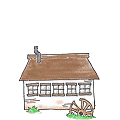
 1
1




 3
3




"The rule of no realm is mine. But all worthy things that are in peril as the world now stands, these are my care. And for my part, I shall not wholly fail in my task if anything that passes through this night can still grow fairer or bear fruit and flower again in days to come. For I too am a steward. Did you not know?" Gandolf




Marco Banks wrote:How steep is the slope? If it's south facing, its going to bake in the summer, so perhaps a bit of shade from those trees that still remain will be welcome.
I would think that your first priority is to shape the land in the way that it'll harvest water and hold it—little swales and sinks. You probably will not be able to create a master system of swales, but that shouldn't stop you from excavating, leveling and doing what you can to harvest as much water as you can and sink it where you want it to remain.
The second priority would be siting your trees below those swales/sinks. Plant your trees, then pile branches and other biomass below them on the slope. The sun will bake the soil below the trees (the south side), so that's where you want to carefully build little slash piles to keep the soil cool and preserve as much water as you can. Within a couple of years, most of this will break down, but it'll help establish the below-soil fungal network. Beyond serving as a thick mulch, those slash piles will also capture leaves and other bio-mass that would tend to want to wash down the slope, so you keep the mulch where it'll do the most good.
Think through how you'll be able to access the trees. I've got a couple of really nice fig trees that I prune every year and that bear heavily . . . but they are such a pain in the ass to get to, it's just food for the stupid green fig beetles. My property is so steep in that location, they are a frustration to climb up and pick, and for figs, you've got to check them almost daily in the fruiting season. Just because you can squeeze another tree into this or that little space, doesn't mean you should. Or maybe you should, and just feed the deer and the animals with the apples that fall. Your call.
My last thought is that you'll want to actively prune the trees that remain. Initially, it may mean just fixing the damage that the loggers did. Thin out the little trees that you don't want to keep, and selectively trim back the others. A cordless sawzall is great for this.
Best of luck. Post some pictures.
 1
1




Oddo Da wrote:
Thanks! I see you are located in California, that makes me think you have to be very careful about water (?). We are in Virginia and here we get anywhere from 47 to 60 inches of rain a year. I am not really concerned about the trees not having enough water, to be honest. What actually concerns me more is erosion after heavy rains. This year has been particularly bad, on the order of 60+ inches of rain and that was a month or so ago. Then we got more and then we got 20 inches of snow and it is raining buckets now again, melting the snow :(
I am usually against large excavation projects as most people (including myself) are ignorant about large scale geo-work but I feel some terracing would help. I have no experience with terracing though - would the terraces be a good place to plant the trees?
Would have easy access to the trees and the slope as I own a 5 acre field above the slope where I grow grains and I have a mowed path around the field where I do my running etc. (so I am always up there haha)
I will post photos! Thanks again!
"The rule of no realm is mine. But all worthy things that are in peril as the world now stands, these are my care. And for my part, I shall not wholly fail in my task if anything that passes through this night can still grow fairer or bear fruit and flower again in days to come. For I too am a steward. Did you not know?" Gandolf




Marco Banks wrote:
Oddo Da wrote:
Thanks! I see you are located in California, that makes me think you have to be very careful about water (?). We are in Virginia and here we get anywhere from 47 to 60 inches of rain a year. I am not really concerned about the trees not having enough water, to be honest. What actually concerns me more is erosion after heavy rains. This year has been particularly bad, on the order of 60+ inches of rain and that was a month or so ago. Then we got more and then we got 20 inches of snow and it is raining buckets now again, melting the snow :(
I am usually against large excavation projects as most people (including myself) are ignorant about large scale geo-work but I feel some terracing would help. I have no experience with terracing though - would the terraces be a good place to plant the trees?
Would have easy access to the trees and the slope as I own a 5 acre field above the slope where I grow grains and I have a mowed path around the field where I do my running etc. (so I am always up there haha)
I will post photos! Thanks again!
47 to 60 inches of rain a year! Oh my -- That's 3 to 4 times what we get. Last year we got 12 inches for the entire rainy season. I'd love to get half of what you get. Send some of the excess our direction!
If you put in swales, then your concern would be shaping them so that the overflow washes down carefully constructed sills to prevent erosion. Never-the-less, I'd still consider digging little sinks above my trees, to catch summer storm runoff and keep the soil wet in July, August and Sept.
Depending upon the angle of your slope, terracing might be a nice solution. But to do so, you will probably need to clear the remaining trees off the land, and that was exactly what (according to the OP) you were trying to avoid. If it's steep you will need to use heavy equipment like an excavator. Sepp Holtzer is the king of shaping his land. If you're not familiar with his work in Austria, he'd be someone worth Googling and Youtubing. He's an old friend of Paul Wheaton, the founder of this forum. He's managed to take his mountainside and turn it into a series of ponds and terraces. He grows grain, raises livestock, and has thousands of fruit trees.
I'd consider that you think about a 50 year solution. Think out a generation and a half. Trees will come and go, but if you shape the land and create a series of terraces on contour, that land will become much more productive with each passing year. Yes, it will be much more expensive that way, and you will not see a harvest as quickly as you would if you just to out there and start popping trees into the ground. But if you could get access to a small dozer for a couple of days, or an excavator or backhoe for a week or two, you might be able to shape the land in a way that you'll enjoy it for a long, long time.
 1
1








Mark Whitecavage wrote:I own a farm in SW Virginia and I agree with the comment about heat on a south slope. That said, depending on the steepness of the slope it can work. The orchards I put in are on a southwest slope, but it’s gentle and my trees have thrived. The two single biggest recommendations I would make are make sure you dig as large a hole as is possible/practical, and make sure you water them regularly the first year (even in the winter). I own a tractor, and an auger that attaches to it, and I use an 18 inch tree auger to dig holes but...before that I’d use a rototiller to break as much ground (in a circle) as I could then deepen it with a shovel. A guy who sold me southern heirloom apple trees recommended I not use potting soil or topsoil in the hole and just refill with the soil I dug out but I do add a little, simply because it seems that what comes out is less than what is needed to refill the hole (weird, right?) and I do think it helps with compaction. Lastly, I also try to make a very shallow bowl around the tree to hold water when I water...but very shallow so as to not drown the tree. I hope this helps!!
 2
2




Mark Whitecavage wrote: A guy who sold me southern heirloom apple trees recommended I not use potting soil or topsoil in the hole and just refill with the soil I dug out but I do add a little, simply because it seems that what comes out is less than what is needed to refill the hole (weird, right?) and I do think it helps with compaction.
"The rule of no realm is mine. But all worthy things that are in peril as the world now stands, these are my care. And for my part, I shall not wholly fail in my task if anything that passes through this night can still grow fairer or bear fruit and flower again in days to come. For I too am a steward. Did you not know?" Gandolf
 1
1




Where do you buy your fruit trees? Have you had any issues with cedar rust? I planted a few last year and 3 out of 6 had it... I have been told also not to use top/potting soil but I do add some of our horses' manure in the holes...
I bought quite a few southern heirloom apple trees from David Vernon at Century Farms, in Eden NC. His family has been doing this for a very long time and the trees are unique, well adapted to the south and mine have done incredibly well. I recommend you check them out online. As for cedar rust - I don’t get it because I spray for it when cedar trees are producing their galls. I believe I would if not for the spray and while it’s not typically fatal, from what I’ve read, I do know it stresses the trees. I’m sure others have strong opinions about spray, but I use it when needed and my trees have thrived. Lastly, deer are brutal on young apple trees so protect them!




Oddo Da wrote:A
Does anyone have experience with this? Questions such as the following come to mind:
1) Planting fruit trees among poplars, oaks and maples? The non-fruit trees are scarce due to select cut so plenty of light. Berries would go on the edges of the forest.
2) Planting fruit trees on a slope? Slope is facing south, is not horribly steep and ends in a creek at the bottom.
We are in SW Virginia. I have been thinking about plums, peaches, persimmons, cherries and paw-paws. Also would like to plant some chestnuts.
Thanks!





|
If you believe you can tell me what to think, I believe I can tell you where to go. Go read this tiny ad!
The new purple deck of permaculture playing cards
https://www.kickstarter.com/projects/paulwheaton/garden-cards
|





